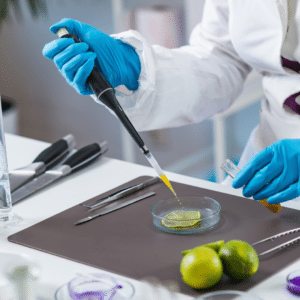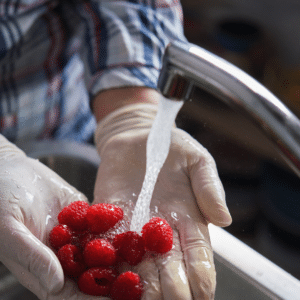 Introduction:
Introduction:
If you are wondering what foods and substances the FDA considers to be Generally Recognized As Safe (GRAS), you have come to the right place. This guide will explain the critical safety standards for GRAS regulation and provide an overview of what products are deemed safe by the FDA.
“Generally Regarded As Safe” (GRAS) is a category of food ingredients used in the United States. The FDA’s GRAS program allows companies to formulate, market, and sell their products without submitting safety data to the agency. The program helps speed up the regulatory process by making it easier for businesses to bring new products to market.
The FDA’s Generally Regarded as Safe (GRAS) regulations are essential to ensuring food additives’ safety in the United States. These regulations help to determine which substances are safe for use in food and which are not. In this article, we’ll take a closer look at the “Generally Regarded as Safe” GRAS regulations and how they work.
The role of the FDA in food safety regulation
The FDA plays a crucial role in ensuring the food’s safety. Its primary responsibility is to protect public health by regulating the production, distribution, and labeling of food products. The FDA’s authority extends to all food products except meat, poultry, and certain egg products, which the U.S. Department of Agriculture (USDA) regulates.
One of the key ways the FDA ensures food safety is by evaluating food ingredients. The FDA assesses the safety of food ingredients based on scientific evidence, industry data, and expert opinions. This evaluation process helps the FDA determine which ingredients are safe for consumption and which may pose a public health risk.
The History and Development of GRAS Regulations
The concept of GRAS has been around for decades, evolving and adapting to the changing landscape of the food industry. The initial regulations for GRAS were established in the 1950s by the U.S. Food and Drug Administration (FDA). These regulations aimed to provide a framework for determining the safety of food ingredients based on their common use in food before 1958 or their long history of safe consumption.
Over the years, the regulations surrounding GRAS have undergone revisions and updates to keep up with scientific advancements and changing dietary patterns. The FDA has been actively involved in evaluating and approving substances for GRAS status, ensuring that they meet the necessary safety criteria.
To be considered GRAS, a substance must meet certain criteria that demonstrate its safety for consumption. These criteria are based on scientific evidence and are evaluated using a rigorous process. The primary factors considered when determining GRAS status include:
1. History of safe use: A substance must have a long history of safe consumption by a significant number of people. This history provides evidence of the substance’s safety over time.
2. Expert consensus: The scientific community should widely agree that the substance is safe for consumption. This consensus is reached through extensive research, studies, and peer-reviewed publications.
3. Scientific data: Scientific data, including toxicological studies, animal testing, and human trials, are essential in assessing the safety of a substance. This data helps determine the substance’s potential risks and any adverse effects it may have.
These criteria ensure that substances considered for GRAS status undergo a thorough evaluation process, leaving no room for ambiguity when it comes to consumer safety.
The process of self-determination and voluntary GRAS notification
Obtaining GRAS status involves a comprehensive evaluation process that includes self-determination and expert review. In the self-determination phase, the manufacturer or supplier of the substance conducts a thorough assessment of its safety based on scientific data and historical use. This assessment is documented and submitted to the FDA for review.
The FDA then conducts its review, which involves evaluating the submitted data, analyzing the scientific literature, and consulting with external experts. The expert review is a critical step in ensuring the credibility and accuracy of the self-determination process. The FDA may request additional information or studies if deemed necessary during this review.
Once the FDA is satisfied with the safety and supporting evidence, the substance is granted GRAS status. It is important to note that the FDA’s review process is transparent, allowing for public scrutiny and input.



GRAS substances are regulated by the FDA under the Federal Food, Drug, and Cosmetic Act. The FDA is responsible for ensuring the safety and integrity of food products, including those with GRAS status. The regulatory framework for GRAS substances includes several key elements:
1. Notification process: Manufacturers or suppliers must notify the FDA about their determination of GRAS status for a substance. This notification includes detailed information about the substance, its intended use, and the basis for its safety.
2. Publicly available records: The FDA maintains a database of GRAS notifications, which is accessible to the public. This transparency allows for public scrutiny and helps maintain accountability.
3. Continuous monitoring: Once a substance is granted GRAS status, it is subject to ongoing monitoring by the FDA. This includes reviewing new scientific data, conducting inspections, and taking appropriate action if safety concerns arise.
The regulatory framework ensures that GRAS substances are held to high standards of safety and undergo regular evaluation to maintain their status.
Controversies and challenges surrounding the GRAS determination process
While the GRAS program plays a vital role in ensuring food safety, it has its controversies and challenges. One of the main concerns is the role of industry self-determination in the GRAS process. Critics argue that the current system allows manufacturers to make self-serving determinations without sufficient oversight from the FDA.
Another challenge is the need for transparent guidelines for making GRAS determinations. The FDA provides general criteria for determining GRAS status. Still, there needs to be more specific guidance on how to conduct safety evaluations. This lack of clear guidelines can lead to inconsistencies in the evaluation process and raise concerns about the reliability of GRAS determinations. Furthermore, there have been cases where ingredients initially considered GRAS were later found to pose health risks. This highlights the need for ongoing monitoring and reassessment of GRAS ingredients to ensure safety.
Case studies of popular food ingredients and their GRAS status
To better understand the practical application of the GRAS program, let’s examine a few case studies of popular food ingredients and their GRAS status.
1. Salt (Sodium Chloride): Salt is a commonly used ingredient in food and has a long history of everyday use. It is considered GRAS by the FDA, but excessive salt consumption has been linked to health issues such as high blood pressure. This highlights the importance of moderation even with GRAS ingredients.
2. Caffeine: Caffeine is another widely used ingredient in coffee, tea, and other beverages. It is considered GRAS, but excessive consumption can lead to adverse health effects, such as insomnia and increased heart rate. Again, moderation is key.
3. Artificial Sweeteners: Artificial sweeteners like aspartame and sucralose are used as sugar substitutes in many products. These ingredients have undergone extensive scientific testing and are considered GRAS. However, some studies have raised concerns about their long-term effects on health.
Frequently asked Generally Recognized as Safe Questions we receive from food manufacturers:
What is FDA generally recognized as safe GRAS?
“Generally Regarded as Safe” (GRAS) is a designation the FDA gives to substances considered safe for food use. This designation is based on qualified experts’ scientific evaluation of the substance’s safety. The GRAS designation is critical because it allows food manufacturers to use certain substances in their products without needing FDA approval. However, it’s important to note that the GRAS designation is not a guarantee of safety, and the FDA can still take action if new information suggests a substance may not be safe.
How are substances determined to be GRAS?
Substances are determined to be GRAS through a scientific evaluation process by qualified experts. These experts review all available data on its importance, including studies on its safety and toxicity, and decide whether it is safe for use in food. The evaluation process also considers the intended use of the substance, the amount that will be used, and the potential for exposure. If the experts determine the ingredient is safe, it can be designated GRAS and used in food products without FDA approval.
What are the requirements for GRAS substances?
A substance must meet specific requirements set forth by the FDA to be considered GRAS. These requirements include a history of safe use in food, a general recognition of safety by qualified experts, and a lack of scientific evidence to suggest that the substance is harmful when used in food. Additionally, the GRAS compound must be used according to good manufacturing practices and not exceed the levels deemed safe by the FDA.
How are GRAS substances monitored for safety?
While GRAS substances are not subject to pre-market approval by the FDA, they are still monitored for safety. The FDA relies on various sources to gather information about the safety of GRAS substances, including scientific literature, reports from industry, and adverse event reports. If new data suggests that a GRAS substance may no longer be safe, the FDA can take action to remove it from the list of GRAS substances or require additional safety testing. Additionally, manufacturers must notify the FDA if they become aware of new information suggesting their GRAS substance is no longer safe.
What is the role of the FDA in GRAS regulations?
The FDA plays a crucial role in ensuring the safety of food additives through its “Generally Regarded as Safe” (GRAS) regulations. While GRAS substances are not subject to pre-market approval, the FDA monitors them for safety and can take action if new information suggests they may no longer be safe. The FDA also requires manufacturers to notify them if they become aware of further details suggesting their GRAS substance is no longer safe. Overall, the FDA’s role in GRAS regulations is to protect public health by ensuring the safety of food additives.
How does GRAS status apply to food products?
GRAS status is granted to products judged to be safe through scientific procedures and accepted by the FDA for use in the market without undergoing formal pre-market approval. When a product meets this classification, food product formulators can draw reasonable conclusions about its safety based on solid science, scientific principles, and existing data. GRAS status can mean different things for different products, so understanding GRAS and its implications is essential when launching your new venture.
What does GRAS mean?
“Generally Recognized As Safe” (GRAS) is a U.S. food and drug safety designation given to certain substances that can be used in food and drugs without additional regulatory approval. When consumed at the levels outlined in FDA regulations, GRAS recipes are extensively investigated and determined by qualified experts as having safe use, no harm, and no side effects. Substances must be proven through scientific tests or an extensive review of published scientific data to be considered GRAS.
How does the FDA determine GRAS status?
Once qualified experts have evaluated a substance, the FDA reviews the data, conclusions, and scientific evidence to determine GRAS status. If the FDA determines sufficient proof that particular implications are safe for food, drugs, or cosmetics, it will issue an official GRAS notice in the Federal Register. The FDA also requires manufacturers of GRAS substances to maintain records to document the safety assessment of their ingredients and to ensure continuous product safety.
What are some examples of common GRAS food substances?
The FDA has identified hundreds of substances as GRAS, including common food ingredients such as baking soda, vinegar, citric acid, and specific colors and flavorings. Other commonly used GRAS ingredients are preservatives like sodium benzoate and potassium sorbate, sweeteners like stevia and xylitol, and spices like capsaicin and ginger. Additionally, some novel ingredients from natural sources, such as seaweed extract gums and starches, have been deemed GRAS by the FDA.
What are the Differences Between GRAS Status, FFC Classification, and Additives Declaring GRAS Status on a Product Label?
It’s essential to understand the differences between FFC classification, GRAS status, and additives when declaring your product’s GRAS classification. The FFC (Food and Food Contact) classification is used for food components made with an ingredient that may be consumed as-is without further processing and that contact food during normal handling. An additive is a substance added to enhance the flavor or preserve the shelf life of food. Finally, GRAS status implies that a product poses no known risk of harm when consumed at the levels normally expected.
How do I declare GRAS status on a food product label?
When preparing to declare GRAS status on a product label, consider taking the following steps: First, determine whether your product is composed of FFC-classified ingredients or meets the definition of an additive. Then, review information on toxicity levels and safe usage data to determine whether the substance meets standards for GRAS classification. Finally, submit all necessary paperwork to the FDA for pre-market certification.
What potential risks are associated with claiming GRAS status on a product label?
Considering the potential risks and consequences of claiming GRAS status for a product is crucial. For instance, if a manufacturer makes a false claim about their product, they may face civil or criminal liability as outlined in the False Claims Act. Additionally, incorrect assertions about GRAS status for products can lead to recalls and other enforcement actions from the FDA.
What is the safety assessment system (SGS) for new self-GRAS ingredients?
The FDA also allows companies to make their safety assessments for novel ingredients and submit a self-GRAS notification. This is called a “self-determination” process; the company assesses the ingredient’s safety and makes a case for why it should be accepted without further FDA review. In most cases, self-GRAS will be subject to future FDA audits or periodic inspections to verify that the ingredient is safe for consumption.
What is the importance of product safety testing in determining GRAS status?
Before an ingredient is deemed generally recognized as safe (GRAS) by the FDA, it must undergo rigorous testing to ensure it meets safety standards. Companies must submit comprehensive safety data, including toxicological profiles, clinical trials, and other scientific evidence, to show that an ingredient is not harmful or dangerous when consumed at specified levels. This includes testing for potential allergens, contaminants, and by-products from production. Product safety testing will help to ensure that any item classified as GRAS does not pose a risk of harm to consumers.
How does the GRAS program help speed up the regulatory process?
The program aims to reduce the regulatory burden on all stakeholders, including industry and regulators. Someone can achieve this through increased transparency in the regulatory process and by preventing unnecessary delays in getting products to market. The number of applications submitted under this program has been growing steadily since its inception in 1992, with more than 50% coming from small businesses or universities with fewer than 500 employees.
How do I distinguish GRAS ingredients from non-GRAS ingredients?
When assessing potential ingredients for a product, there are several key factors to consider to ensure that you are using a GRAS (generally recognized as safe) ingredient. It’s essential to research the ingredient’s history and ensure that it has been reviewed and approved by the FDA or that an independent panel of experts has declared it safe. It must also be able to meet specific criteria about its characteristics, composition, intended use, and safety concerns. If these criteria are met, an ingredient can be considered GRAS by designation.
What are some commonly used natural GRAS ingredients?
Natural GRAS ingredients are widely used in the food, health, and beauty industries to add nutrition and provide supplemental benefits. Commonly used natural GRAS ingredients include:
- Oils like coconut, palm, and olive oil.
- Plant-based starches like tapioca starch.
- Vitamins, minerals, herbs, and spices are derived from natural sources.
- Probiotics.
- Sweeteners like honey and agave syrup
- Raw food dyes such as carmine, turmeric, saffron, and annatto
What are some benefits of using natural GRAS ingredients in formulations?
Using natural GRAS ingredients in formulations is beneficial for many reasons. Natural GRAS ingredients can offer health benefits such as increased energy, improved digestion, enhanced cognitive function, improved skin and hair quality, and weight management assistance. Natural GRAS ingredients are also often easier to digest than artificial options, which makes them more accessible for the body to utilize. Additionally, natural GRAS ingredients generally have fewer side effects than synthetic options.
How can I avoid potential safety hazards with proper research and testing?
To ensure natural GRAS ingredients are safe for consumption, it’s essential to research and test each component thoroughly and correctly. Someone must identify the potential safety hazards before any raw GRAS ingredients can be validated. It’s also important to double-check the source of all elements before sourcing and ensure they meet the specifications set forth by governing bodies. Additionally, products made with natural GRAS ingredients should have good quality assurance processes to ensure compliance with applicable laws and regulations.
What does “Generally Regarded as Safe” (GRAS) mean in food regulations?
Generally Regarded as Safe” (GRAS) is a designation used in food regulations to indicate that a substance is considered safe for consumption based on a history of everyday use in food or scientific evidence, without formal approval as a food additive.
How is a substance determined to be GRAS?
To be considered GRAS, a substance must have a consensus among qualified experts that it is safe for its intended use in food. This determination can be based on historical usage, scientific studies, or both. The safety assessment should be publicly available for scrutiny.
Who determines if a substance is GRAS?
Determining whether a substance is food manufacturers or ingredient suppliers typically makes GRAS. They compile scientific data and expert opinions to support the substance’s safety. The U.S. Food and Drug Administration (FDA) can review and question these determinations.
Is GRAS status permanent?
No, GRAS status is not permanent. It can be subject to change if new scientific evidence emerges suggesting a safety concern. The FDA can reevaluate and challenge GRAS determinations if necessary.
Are all food additives required to go through the GRAS process?
No, not all food additives need to go through the GRAS process. Some substances are explicitly recognized as safe by the FDA and are exempt from the GRAS determination process. Others, especially new additives, may require formal approval.
Can consumers find information about GRAS substances on food labels?
Generally, GRAS status is not listed on food labels. However, food manufacturers must ensure that all ingredients used in their products, including those with GRAS status, meet safety standards set by regulatory authorities.
What are some common examples of GRAS substances?
Common examples of GRAS substances include salt (sodium chloride), sugar (sucrose), vinegar (acetic acid), and various vitamins and minerals when used under established guidelines.
Is GRAS status the same globally?
No, GRAS status and regulations can vary from one country to another. Each country or region may have its criteria and process for determining whether a substance is generally considered safe for food use.
Can individuals petition for a substance to be considered GRAS?
Yes, individuals or organizations can submit a GRAS notification to the FDA, providing scientific evidence and expert opinions supporting the safety of a substance. The FDA reviews these notifications and can respond with their evaluation.
Are there any controversies or concerns related to GRAS determinations?
Yes, concerns have been raised about the transparency and potential conflicts of interest in GRAS determinations, as some decisions are made by the same companies that produce the substances in question. Efforts have been made to address these issues and enhance the rigor of the process.
Additional Reading about GRAS:
- Gras Certification in the Food Industry
- Benefits of a Self-Affirmed GRAS Dossier for your business
- Navigating the GRAS Process for food manufacturers
- FDA GRAS Status
- GRAS List for Food Additives food safety
- Everything to know about GRAS Ingredients
- FDA GRAS Notice & GRAS Database
- NDIN vs GRAS Certification
- GRAS, NDI, ODI Food Additives Unlocked


